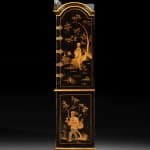A QUEEN ANNE BLACK-JAPANNED SECRETAIRE-CABINET
W: 41” / 104cm
D: 21” / 53cm
Further images
Provenance
The Cesari Family, Rome, Italy
Literature
Edwards, R. & Macquoid, P., The Dictionary of English Furniture, Vol. II (London, 1954), p.161, fig. 19
A. Bowett, Early Georgian Furniture: 1715-1740 (Woodbridge: 2009), figs. 3.82-83
A Queen Anne black and gilt-japanned secretaire cabinet, the re-entrant double domes with silvered finials above two finely japanned doors depicting elaborate trade scenes, figures, foliage and land and seascapes, mounted with elaborately engraved hinges, corner mounts and a central lock plate, the upper part with a fully fitted interior of drawers, the lower part fitted with a secretaire drawer, and similarly decorated, depicting houses and landscapes, above three long drawers, standing on bun feet
The courts and nobility of Europe had long been fascinated by the exoticism and mystery of the Orient. The huge growth in trade through the East India Company in the late seventeenth century stimulated interest and demand further. Especially popular and a subject of great interest was ‘chinoiserie’.
Along with silks and porcelain that were imported at this time were lacquer screens and cabinets, and these pieces were highly sought after by society, and so of particular interest to the cabinet-makers in England, who created similar examples using technique of japanning.
Japanning was popularised further by the publication of 'A Treatise of Japanning and Varnishing' by John Stalker & George Parker, which describes in detail the process of japanning. This publication remains a key reference book for the technique even today.
The Cesari family were important textile entrepreneurs, and owners of the iconic Cesari in Rome, led by founder Luigi Cesari. The company provided textiles for important rooms of prominent families around the world. Earning a reputation for sophisticated and exceptional quality products, they became a symbol of Rome’s Dolce Vita.









